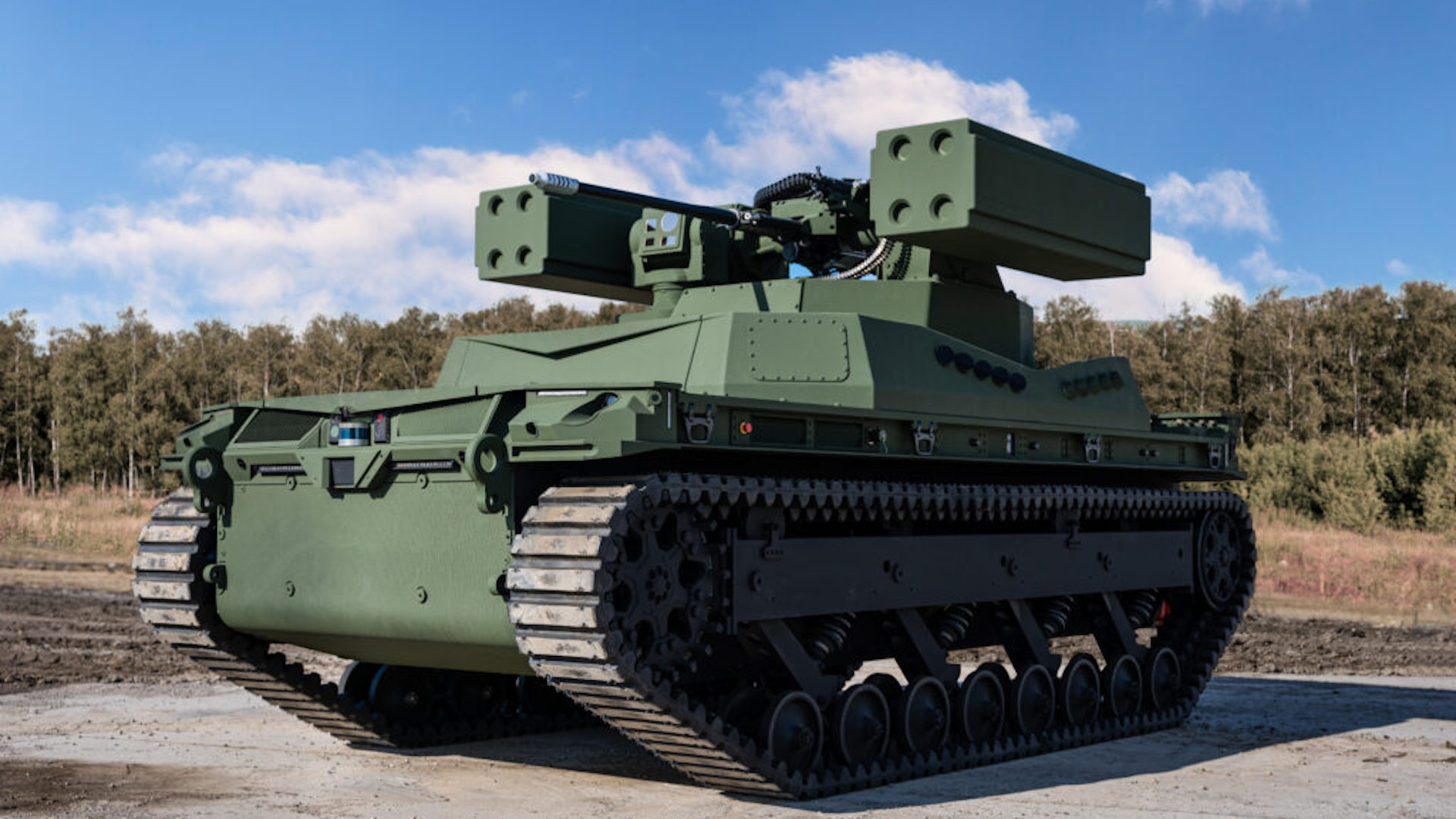

A major U.S. defense contractor has unveiled a new unmanned ground vehicle bristling with missiles and a chain gun for the Army’s consideration as the service explores new systems for short-range air defense amid an ongoing modernization push for troops deployed to Europe.
Appearing at the Association of the U.S. Army’s Global Force Symposium in Huntsville, Alabama this week, General Dynamics Land Systems debuted its Tracked Robot 10-ton (TRX) technology demonstrator outfitted with the company’s Manuever-Short Range Air Defense (M-SHORAD) system which normally tops select Stryker Infantry Fighting Vehicles.
The M-SHORAD system that appeared atop the TRX in Huntsville this week consisted of a Moog Reconfigurable Integrated-weapons Platform (RIwP) turret touting FIM-92 Stinger missiles, an XM914 30×113 mm chain gun, and a 7.62mm M240 machine gun in a mission equipment package developed by U.S. defense contractor Leonardo DRS to defeat incoming unmanned aerial vehicles and rotary wing aircraft.
Subscribe to Task & Purpose Today. Get the latest military news, entertainment, and gear in your inbox daily.
First fielded in November 2020 to the 5th Battalion, 4th Air Defense Artillery Regiment amid the unit’s deployment to Germany, the M-SHORAD system is designed to effectively transform the tried-and-true troop transport into a mobile air defense system capable of defending against drone and helicopter threats in a near-peer fight.
As Task & Purpose has previously reported, the deployment of M-SHORAD systems came in the aftermath of Russia’s annexation of Crimea in 2014 when the Army identified an urgent capability gap in its short-range air defense systems for brigade combat teams deployed to Europe that had persisted since the end of the Cold War, a need that has likely grown only more acute amid the Russian invasion of Ukraine last year.
General Dynamics Land Systems, which will see 144 of its M-SHORAD systems fielded to 4 battalions by the end of fiscal year 2023, is “trying to demonstrate the ability to go beyond that both in the Stryker formations and heavy brigade formations, i.e., our heavy divisions” with the missile-toting TRX, as GDLS U.S. business development director Scott Taylor told Defense News.

The TRX, first unveiled in October 2020 at the Association of the U.S. Army’s annual convention in Washington, D.C., is an outgrowth of the unmanned technologies behind the Small Multipurpose Equipment Transport (SMET) robotic vehicle which GDLS delivered to the Army in November to serve as a “robot mule” for overburdened soldiers.
The platform “is designed to meet a variety of critical missions such as direct and indirect fires, autonomous resupply, complex obstacle breaching, counter-unmanned aerial systems, electronic warfare, and reconnaissance,” as Defense News reported at the time, noting that the system is “fast enough” to keep up with “high-speed” maneuver formations like Stryker and armored BCTs.
The TRX itself was developed as GDLS’ bid upcoming Robotic Combat Vehicle competition, which for the last several years has seen the ARmy test testing light, medium and large variations of the RCV outfitted with remote weapons stations bristling with XM813 Bushmaster chain gun, .50 caliber machine guns, and FGM-148 Javelin missile launchers, even pairing armed RCVs with Green Berets from the 1st Special Forces Group during a two-week experiment last year.
Despite these tests, the actual fielding of an armed RCV appears a long way off. As Breaking Defense reports from Huntsville, the Army has been “tight-lipped” about the specific requirements surrounding next year’s RCV competition beyond confirming that the service is asking Congress for $142 million in fiscal year 2024 for a prototyping competition as part of a larger modernization push. The Army requested $115.98 million in fiscal year 2023 for RCV development, according to a Congressional Research Service report, with lawmakers appropriating $109.84 million for the program in December of last year.
While the prospect of armed robots keeping an eye on the skies in a conflict against a near-peer adversary like Russia may seem like the beginning stages of a whole SkyNet thing to some observers of robotic warfare, don’t worry: according to the CRS report, the Army envisions its RCVs controlled by nearby operators rather than relying on artificial intelligence, a vision inline with the Defense Department’s broader approach to autonomous weapons systems.
But given the Pentagon’s ongoing push to develop and field new and innovative air defense systems to Europe to counter Russia, it may only be a matter of time before a GDLS M-SHORAD battle bot may be watching your ass downrange.
The latest on Task & Purpose
- No, the VA isn’t going to reduce your disability payments if you make too much money
- Air Force 1-star general relieved for ‘shortfalls’ in personal conduct
- What are America’s goals in Ukraine? It’s not totally clear
- Russia is dusting off ancient tanks as losses mount in Ukraine
- How the Battle of Nasiriyah foreshadowed the long slog of the Iraq War